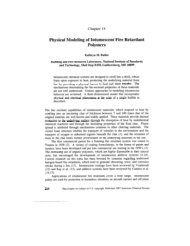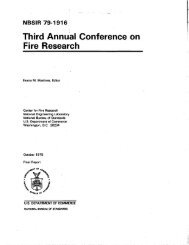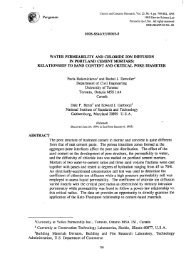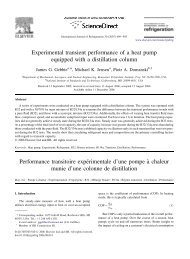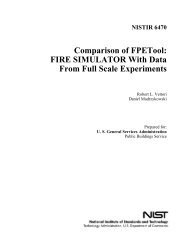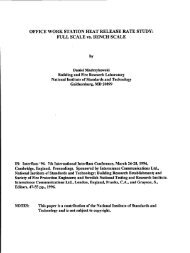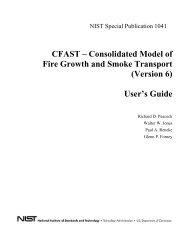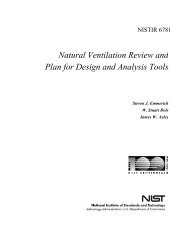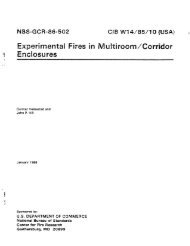Study of Technology for Detecting Pre-Ignition Conditions of ... - NIST
Study of Technology for Detecting Pre-Ignition Conditions of ... - NIST
Study of Technology for Detecting Pre-Ignition Conditions of ... - NIST
You also want an ePaper? Increase the reach of your titles
YUMPU automatically turns print PDFs into web optimized ePapers that Google loves.
-.<br />
.<br />
CPSC-IAG95-1145<br />
(9/16 in) inside diameter ends <strong>of</strong> 1.2 mm (3/64 in) wall thickness and 31.8 mm (1 .25 in) height,<br />
and the support tubes were 113 cm (44.5 in) long. The probe end was located approximately<br />
36 cm (14 in) above the burner surface and centered above the pan. Since most velocity<br />
measuring instruments are hindered by particle-laden flows, a hi-directional probe was<br />
implemented because <strong>of</strong> its ability to per<strong>for</strong>m in smoke-laden flows such as are produced by prefire<br />
and fire conditions.6 The probe was connected to a Setra model 264 pressure transducer <strong>for</strong><br />
which the range was +J4.9 Pa (M. 1 inches <strong>of</strong> water) with an output <strong>of</strong> 2.5 Vdc <strong>for</strong> zero<br />
differential pressure and 10 Pa/Vdc sensitivity. The transducer excitation was accomplished with<br />
a Setra model 2195 regulated 12-28 Vdc power supply.<br />
2.2.4 Fourier Trans<strong>for</strong>m Infrared Spectrometer<br />
The spectrum clf major gas species above the cooking area was measured using an openpath<br />
Fourier trans<strong>for</strong>m infrared spectrometer (FTIR). A MIDAC Corporation Model M2501-C<br />
detector and Model M2402-C source were placed approximately 1.6 m (63 in) apart with the<br />
burner <strong>of</strong> interest approximately centered between them. The two units were positioned at a<br />
height such that the center <strong>of</strong> the 3.8 cm (1.5 in) diameter infrared beam passed through the<br />
center axis <strong>of</strong> the pan approximately 15 cm (6 in) above the burner surface. The spectrometer<br />
spectral resolution wax set to 4 cm- 1. Each set <strong>of</strong> sixty-four spectra was signal-averaged over<br />
20 seconds to provide each data point.<br />
2.2.5 Infrared Video<br />
& infrared video camera was used to obtain thermal imagery <strong>of</strong> the cooking environment<br />
over time so comparisons could be made <strong>of</strong> maximum temperatures and temperature gradients<br />
in the period preceding ignition. The camera used was an Inframetrics model 525 camera and<br />
power supply. It was connected to a Canon VR-20 portable video recorder and a JVC TM-22U<br />
color video monitor. The camera was directed from an angle approximately 20° above the<br />
horizontal plane <strong>of</strong> the burner and was located at sufficient distance to focus on a view that<br />
included the burner, pan, some <strong>of</strong> the food, about 15-20 cm (6-8 in) on each side <strong>of</strong> the pan, and<br />
about 25 cm (10 in) above the pan. The area framed by each image was about 56 cm (22 in)<br />
wide by 39 cm (15 in) tall. The videotapes were reviewed, and individual Ill image frames were<br />
digitally analyzed at 1 second, 45 seconds, and 90 seconds be<strong>for</strong>e ignition.<br />
Two blackbody sources were utilized <strong>for</strong> calibration <strong>of</strong> the infrared video images. The<br />
Mikron model M-310 source was set at 300 “C, and the Barnes Engineering source was set at<br />
511 “C. The Mkron source provided a continuous readout <strong>of</strong> the temperature, but a Fluke model<br />
52 IUJ thermometer was necessary to monitor the Barnes Engineering source while recording the<br />
calibration video.<br />
2.2.6 Standanl Video and Photographic Equipment<br />
A VHS video tamer% Panasonic AG-170 Proline, was approximately centered outside <strong>of</strong><br />
13



